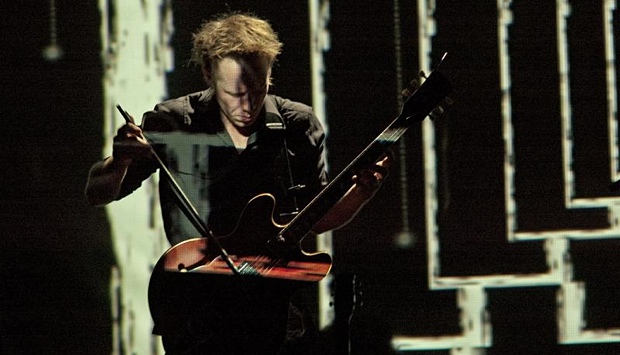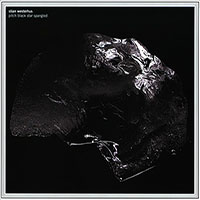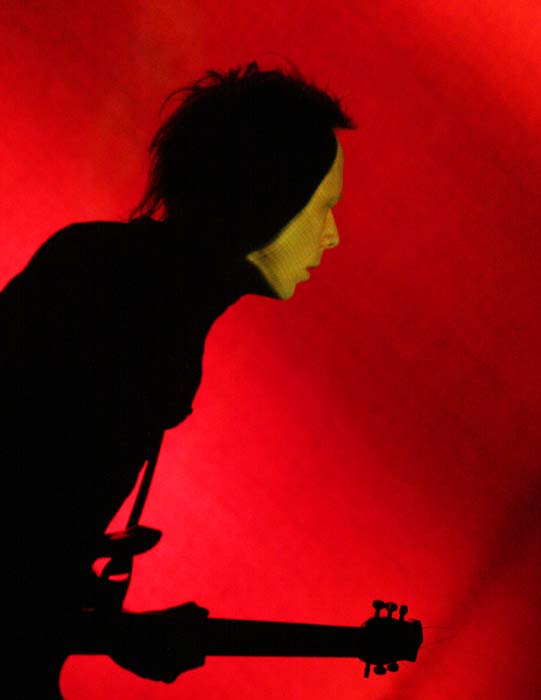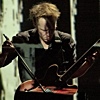Home » Jazz Articles » Interview » Stian Westerhus: The Existential Dimension of Music
Stian Westerhus: The Existential Dimension of Music

All About Jazz: Do you remember when you first heard Jimi Hendrix?
Stian Westerhus: I remember it very well. I was ill at home lying on the couch drowsy with fever and the TV was on. They were showing a documentary about Woodstock. I woke up towards the end and heard Jimmy Hendrix playing "Star Spangled Banner." I was completely mesmerized. I remember getting up and turning up the TV. I had probably heard it before, but that's when it clicked in. I was 13, the age when you start absorbing music. My father had been trying to teach me guitar ever since I was six, without much success. After the film was over I picked it up and I thought, how do I do this? And I just practiced and practiced and practiced. From that moment on I was inseparable from my guitar.
AAJ: Do you come from a musical environment?
SW: Yes. My grandfather tried to teach me accordion. He was very good at playing traditional Norwegian tunes on it. My dad became an opera singer at the age of 48, and there was always music around the house. My mom was listening to Elvis; my dad was listening to opera, to classical music and jazz, and later I was listening myself to a lot of rock stuff.
AAJ: What circumstance or event do you consider to have been crucial for your development?
SW: There are many things that made an impact on me along the way. But definitely the earliest thing was before I started school. I was maybe six, and my sister, who was five years older, had one of those portable cassette players. I used to steal it from her room when she was not home, because I was obsessed with Mike Oldfield's tune "Moonlight Shadow." I used to play it again and again. I also remember the first time I had been given a tape with King Crimson; I was totally blown away by the improvised stuff. I think I have been very lucky, because everybody I have played with had an impact on me and showed me new music.
AAJ: Do you listen to music with a certain purpose in mind, like following a specific sound or manner of interpretation?
SW: Not at all. I just absorb what comes my way. Sometimes I don't even remember who is playing and I really don't care if something I hear is rock or jazz.
AAJ: What are you listening to these days?
SW: I'm not going to tell you that [laughs]. I am not giving away my playlist.
AAJ: Was there any time when you were listening to a lot of classic jazz?
 SW: I tried to listen a lot to it when I was studying, and got into jazz history and theory. I really liked it but it doesn't transcend into my music that much. I mean, some of the Miles Davis electric stuff does. I also like that straight-ahead drive that swing has. Otherwise, I admire and respect it but it doesn't really move me.
SW: I tried to listen a lot to it when I was studying, and got into jazz history and theory. I really liked it but it doesn't transcend into my music that much. I mean, some of the Miles Davis electric stuff does. I also like that straight-ahead drive that swing has. Otherwise, I admire and respect it but it doesn't really move me.AAJ: What is the main connection leading back to your sources of influence?
SW: I don't have heroes, you know, and I don't want to be stuck with the idea of belonging to a style or another. I am taking in so many influences that I sort of end up between all the chairs. To be honest, I think that that's how musicians develop their filters in order to sound like themselves. If you become a fan of Bill Frisell, you end up sounding like him. It is not about the people, it is about the music. I think, by the way, that Jimi Hendrix has done quite a bit of crap, too.
AAJ: Listening to your solo album, Pitch Black Star Spangled (Rune Grammofon, 2010), it raised the question: what does a recording session look like?
SW: The whole thing about my solo projects is that there is a dogma when it comes to the recording process. I do everything myself without technicians, and nobody gets to hear it before it is finished, not even the record company. When I record it I do a lot of improvised stuff, then I leave it for a while in order to get a different angle. And when I listen again, I want to throw most of it away and start recording again. So, you see, it is quite a process to leave out the stuff that comes easily and select the ideas that sort of pop up. At some point I became disgustingly tired of myself while I was recording Pitch Black Star Spangled, because it is very similar to recording what you are saying during the day for a whole month and then listening back to it, over and over again. As you can imagine, there is a lot of crap in there but in the end you suddenly realize that there is something else there, too. Nevertheless, you have no idea where you are going. That's the whole point, because if I knew what I was searching for, I would do it right away.
AAJ: Are there conscious criteria at work or it is all rather an intuitive process?

SW: There are no conscious criteria. I can identify the moment when I feel that something is right, but I can't explain it. It just sounds right and I know that I will have to work on it, take the idea and see where I end up. In a way, I surprise myself sometimes and try to challenge myself. There are tracks on Pitch Black Star Spangled where I was really wondering if I could release them; I was listening to them wondering if I really sounded like that. And afterwards, you realize that it was there all the time, only you didn't dare to go in that direction and open that door. It feels really like you are diving into a black hole, not knowing what you are searching for. But in the moment, you find something; it automatically leads you on without any filters. It is almost like improvising in a live situation but a lot slower, much more like composing. Like now, I am working on a new album and the same thing is happening again. I think that people are going to slaughter me for this album but I can't go any other way.
AAJ: What makes the identity of an album? Is there a leading thread?
SW: No such thing. But if you go for the substance and follow your intuition, it will take you there and provide the cohesion. I really try not to think at all, I just follow my intuition. Music is a very physical thing for me, you know, I need to feel it in my body to know that it is right.
AAJ: "Sing with Me, Somehow" suggests a melodic line fluctuating into the abstract. Are you always chasing the melody, or just playing with the sounds that belong to the same harmonic context, exploring their potential?
SW: I don't think melody is anything unless you put it in context. It is like a word, you have to put it into context to enhance its meaning. Even in the most abstract context, I know where the melody is; it is always there. But it doesn't really matter. Sometimes I step back and I look at a composition from the outside to make sure that it has all it needs, but I always try to analyze as little as possible, and rather try to identify with the music instead—to become it.
AAJ: Were you surprised when you saw that your music was making an impact on people and other musicians?
SW: It is a huge privilege for me to get to play with people I admire most and sometimes I have to stop for a while in order to realize how much fun I am really having by doing it. Yes, sometimes I am surprised about the audience who are themselves surprised to find out that they enjoy my music. On the other hand, I don't think I am popular enough to be surprised about people liking me. It is great to get the feedback, too. I've been talking to a lot of people who were listening to my music in a non-musical environment, like an art show for example, and they told me that they have been completely blown away by its honesty and directness.
AAJ: That sounds like the piece you played with the Trondheim Jazz Orchestra; it has a very strong existential dimension.
SW: That's great to hear, because when I wrote that music I felt the same way. That's why I am saying that I need to be physically involved, otherwise it is just noise or entertainment, but not a performance.
AAJ: You don't plan what you will play in your solo shows. What are the factors of influence there? Are they immediate in nature, like the mood you are in or the audience?
 SW: Like all musicians, before I go on stage I first have to enter the musical space mentally. I actually start my performance backstage. It is not like you are starting up an engine. In the first two minutes I sort of intuitively adapt myself to the sound and the room, and from there on it is a whiteout. There is no other factor. Of course, if I am tired it takes extra effort because then I listen to myself and I know that I can do better. If I don't feel that energy it is hard, but most of the time it is just letting go.
SW: Like all musicians, before I go on stage I first have to enter the musical space mentally. I actually start my performance backstage. It is not like you are starting up an engine. In the first two minutes I sort of intuitively adapt myself to the sound and the room, and from there on it is a whiteout. There is no other factor. Of course, if I am tired it takes extra effort because then I listen to myself and I know that I can do better. If I don't feel that energy it is hard, but most of the time it is just letting go.AAJ: Your solo performances have a very strong synesthetic quality; they represent a visual soundscape in the truest sense of the word. Do you visualize your music?
SW: When I work in the studio I visualize the different elements and the different contexts and ideas of my music, but not in a cinematic way. It is more about shapes and how things have their own energy and stand in relationship to each other. It is the point of incidence that is interesting, because there you can see how things start influencing each other. I can visualize that quite well but rather in a theoretical manner.
AAJ: You are involved in many parallel projects, like the one with Nils Petter Molvaer, Sidsel Endresen and Puma. What defines each of these synergies?
SW: The musical heritage and the way of thinking and approaching music is what we have in common here. That is a very important factor. Both Nils Petter and Sidsel—or the group Puma—are, of course, very good with their instruments, but they are also actively involved with the conceptual aspect of music. Even if we come from very different musical backgrounds, that is the real point of fusion.
 AAJ: Is your music provocative?
AAJ: Is your music provocative?SW: I see myself as pretty straight, actually. For me, the important thing is to keep my music as pure and honest as I can, and to make the people listen to what I have to say without trying to provoke, or counting on a certain reaction. If people feel provoked by my music, that's their business.
AAJ: When do you feel that you have reached your aim?
SW: That's a good question. When I feel that the audience is listening to the fullest extent, and you can hear that people are holding their breaths. Then it gets super-quiet, and you know that they have been with you for the whole concert. For me, that is a great feeling, because it is as if the audience were embracing me. That's when I know that I have reached my aim.
AAJ: Your new album together with Sidsel, Didymoi Dreams, has just been released. Please talk a little about it, and working with Sidsel.
SW: Didymoi is a notion connected with the dynamic suggested by the duality of the Twins. The whole record—which I am actually very excited and scared about—is an unedited concert from a festival in Norway. We recorded five or six concerts; we did a lot of listening and I wrote down certain ideas during the auditions. When I came to this one, I just wrote one sentence and then did nothing else but listen. When the recording was over we knew that it was what we wanted. So, we both agreed to publish it as an album. There are moments on it when you can hear that we are transcending from one idea to the other, and I think that is the beauty of it, because it describes this duality extremely well.
I still remember that, after that concert, I had a sense of accomplishment. We both felt that it was OK, because the whole thing was so focused. We didn't plan anything; it was just a release, and the audience really liked it. I have no idea why. Now, when I look back I can see there is instant communication throughout the whole album. That makes it very gentle too. What I really like about this album is that every time I listen to it I still get surprised about what each of us is doing there, about the communication and what it brings out. There is so much happening in that music. Suddenly things take a left turn and then something completely different happens. Sidsel also sings in a way I have never heard before. That's one of the things I am most happy about.
AAJ: What are you working on?
SW: My new solo album will be out end of August beginning of September. I don't have a name for it yet. That is taking a lot of headspace at the moment. I have started writing more music again and I have some plans there running too. I will do the Trondheim Orchestra concert again, so I am writing for that too. In autumn I am going on tour with the solo thing, and will have some more gigs with Sidsel. My main intention actually is to put more energy into fewer projects.
Selected Discography
Sidsel Endresen/Stian Westerhus, Didymoi Dreams (Rune Grammofon, 2012)
Nils Petter Molvaer, Baboon Moon (Sula, 2011)
Stian Westerhus, Pitch Black Star Spangled (Rune Grammofon, 2010)
Puma, Half Nelson Courtship (Rune Grammofon, 2010)
Stian Westerhus, Galore (The Last Record Company, 2009)
Puma Marhaug, Fist Full of Knuckles (Knuckleman Records, 2009)
Monolithic, Black Science (RoggBif/Vendlus, 2009)
Terje Isungset, Laden With Rain (FMR Records, 2008)
Photo Credits
Pages 1, 2: John Kelman
Page 3: Madli-Liis Parts
Tags
Stian Westerhus
Interview
Adriana Carcu
Nils Petter Molvaer
Sidsel Endresen
Jimi Hendrix
Miles Davis
Bill Frisell
Trondheim Orchestra
John Kelman
PREVIOUS / NEXT
Support All About Jazz
 All About Jazz has been a pillar of jazz since 1995, championing it as an art form and, more importantly, supporting the musicians who make it. Our enduring commitment has made "AAJ" one of the most culturally important websites of its kind, read by hundreds of thousands of fans, musicians and industry figures every month.
All About Jazz has been a pillar of jazz since 1995, championing it as an art form and, more importantly, supporting the musicians who make it. Our enduring commitment has made "AAJ" one of the most culturally important websites of its kind, read by hundreds of thousands of fans, musicians and industry figures every month.






















